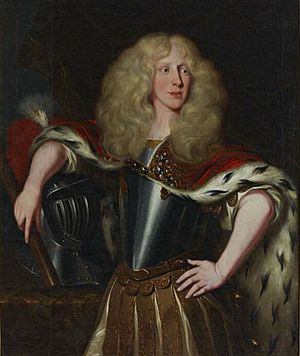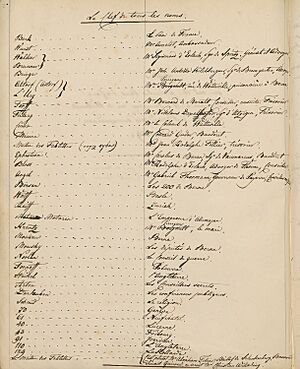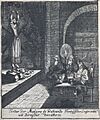Katharina Franziska von Wattenwyl facts for kids
Quick facts for kids
Katharina Franziska von Wattenwyl
|
|
|---|---|

1674 oil portrait by Theodor Roos of von Wattenwyl in armor
|
|
| Born | December 1645 |
| Died | 21 November 1714 Valangin Castle, Valangin, County of Neuchâtel
|
| Occupation | spy |
| Spouse(s) |
|
| Children | 2 |
| Parent(s) | Gabriel von Wattenwyl Barbara von Wattenwyl |
Katharina Franziska von Wattenwyl (born December 1645 – died 21 November 1714) was a Swiss noblewoman who worked as a spy. During a major conflict called the Nine Years' War, she secretly gathered information for Louis XIV, the King of France. Because of this, she was arrested and held in a prison called Käfigturm. She faced serious charges like spying and betraying her country in the city of Bern.
In 1690, she was sentenced to death. However, her family asked for a lighter punishment. Her sentence was changed to living in exile for the rest of her life. This meant she had to leave Bern and could not return. She was set free from prison in 1692. Katharina then went to Valangin Castle in the County of Neuchâtel, where she lived until she died. While in exile, she wrote a book about her life, which she dedicated to her second husband, Samuel Perregaux.
Contents
Early Life and Adventures
Katharina Franziska von Wattenwyl was born in December 1645 at the Bonmont Abbey in Chéserex, Switzerland. She came from a very important family in Bern, known as a patrician family. She was the youngest of eleven children. Her father, Gabriel von Wattenwyl, was a local official called a bailiff. Her mother was Barbara von Wattenwyl, who was also her cousin.
Katharina grew up at Oron Castle in Vaud. When she was thirteen, both her parents passed away. After that, she lived with different relatives.
Katharina was a very skilled horse rider. When she was a young woman, she went to live at the French royal court. At age twenty, she had a disagreement with a French noblewoman. They decided to have a duel on horseback at night, using pistols. When they found out their pistols had no bullets, they continued the duel with swords! A relative eventually stopped the fight. News of this exciting event spread across Europe. Even Christina, Queen of Sweden, invited Katharina to be her lady-in-waiting. However, Katharina's family stopped her from accepting. Queen Christina had become Catholic, and the von Wattenwyl family were strong Protestants.
Another time, Katharina managed to ride a horse that no one else could control. The horse's owner was so impressed that he gave her a pair of special double-barrel pistols. She even used one of these pistols to shoot a count from Electoral Palatinate who bothered her during a hunt.
Katharina's Marriages
Katharina's relatives were worried about her bold behavior. They thought it was not proper for a lady of her high social standing. So, they encouraged her to get married. She chose a man from the noble von Diesbach family. But she was not allowed to marry him because he was Catholic.
She turned down all the other men her family suggested. Finally, she was married to Abraham Le Clerc, even though she did not want to. He was a young Protestant pastor in Bern. Katharina wanted to avoid the strict rules of Bernese society. So, she arranged for her husband to become a pastor in a smaller town called Därstetten.
After her first husband died, she married again in 1679. Her second husband was Samuel Perregaux, who was a court clerk and mayor of Valangin. With Samuel, she had two children: Théophile and Elisabeth.
Working as a Spy for France
Katharina von Wattenwyl admired and supported the Bourbon monarchy of France. During the Nine Years' War, the French king Louis XIV had taken control of areas like Alsace and Strasbourg. He also cancelled the Edict of Nantes, which had protected Protestants called Huguenots. This led to many Huguenots fleeing to Bern. Their arrival made many people in Bern, especially in the government, feel angry towards France. Because of this, French supporters in Bern lost their power.
Leaders in Bern started holding secret meetings to discuss possibly joining forces with the English king. The French ambassador, Michel Amelot de Gournay, was in a nearby town. He hired Katharina von Wattenwyl to get secret information from these Swiss meetings for the French court. Katharina sent letters with important details to de Gournay using a messenger. Some of this information came from the pro-French mayor of Bern, Sigmund von Erlach.
In December 1689, her messenger was caught. Katharina von Wattenwyl was then arrested in the middle of the night. She was imprisoned at Käfigturm and faced very difficult questioning for several weeks.
In 1690, Katharina was found guilty of betraying her country in a trial in Bern. She was sentenced to death. However, her family worked hard to help her. They successfully got her sentence changed to a life of exile from Bern. In 1692, she was released from prison. She found safety at Valangin Castle in the County of Neuchâtel, where she lived until she passed away. While in exile, she wrote a book about her experiences, which she dedicated to her husband.
Her Lasting Impact
The artist Joseph Werner showed his disapproval of Katharina's trial and harsh treatment. Between 1690 and 1691, he created small paintings called miniatures. In these, he suggested that Katharina was unfairly blamed in the arguments between those who supported France and those who did not. Werner was asked by Beat Fischer von Reichenbach to create drawings that defended Katharina von Wattenwyl.
Katharina's life also inspired books. Adolf Frey wrote a novel in 1912 called Die Jungfer von Wattenwyl, which was based on her story. Later, in 2004, Therese Bichsel also wrote a novel about her, titled Catherine von Wattenwyl.
Images for kids





